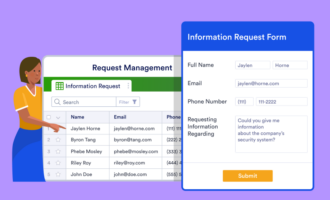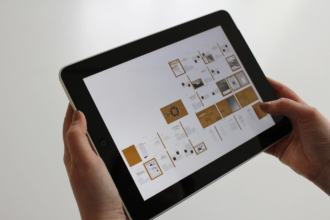Steps to create project management workflows
- Set project goals
- Gather project data
- Create a workflow diagram
- Get team member support
- Adopt the right software
Have you ever been grocery shopping without a list? Despite going in with the best of intentions, you may forget certain necessities and instead overload on items that you don’t really need.
Professional projects can be equally chaotic if they’re not properly planned. “Without careful planning, project performance is almost certainly guaranteed to suffer,” writes Moira Alexander, founder of PMWorld 360 Magazine and Lead-Her-Ship Group.
That’s why creating a project management workflow is so important. Discover our five simple steps for implementing one today — plus how Jotform can help.
The importance of a project management workflow for businesses
With projects involving so many people, processes, and moving parts, they can be prone to miscommunication.
“Trying to get everybody talking in the same language or doing things the same way is difficult,” says Jennifer Bridges, founder of PMP certification education platform PDUs2Go.com.
The solution to overcoming this challenge? A clear project management workflow. No matter how big or small, or how complex or simple the project may be, project management workflows improve the productivity and efficiency of teams — helping to ensure projects meet all requirements upon delivery.
The benefits of building a project management workflow
Creating project management workflows can completely transform your organization’s productivity. Projects run more smoothly, and staff are aligned on their functions within the project delivery scope.
By providing a clear set of rules to follow, your organization can benefit from
- Improved productivity and efficiency: Team members are less likely to miss steps or perform unnecessary tasks that impede maximum productivity. This keeps projects on schedule and within budget.
- Better collaboration and accountability: Everyone can see who’s working on what and where they are in the project, increasing each person’s accountability for their part in the process.
- Greater transparency: Key information is centralized within workflows, leading to greater operational efficiencies and reducing the time needed for team members to seek information.
While there are some learning curves associated with implementing new workflows, the benefits you can realize far outweigh any challenges that may present themselves in the beginning stages of developing more detailed workflows.
5 steps to create a project management workflow
Each project workflow will be unique. Project managers are responsible for creating customized workflows that fit the expectations and requirements for each project.
However, there are some basic steps involved in building a project management workflow that serve as a blueprint to get started:
1. Set project goals
It’s often easier to visualize steps when working from end to beginning. Think about what you want this project to accomplish. Are you hoping to increase product sales? Boost brand awareness? Implement a new tool? With the goals in mind, you can then work backwards to establish all the tasks that your team needs to accomplish for the project to be successful.
2. Gather project data
Next, collect as much information as possible in relation to the completion of the project — no detail is too small to take note of, as each piece of data informs task creation and the project’s workflow. Consider items such as physical assets, tools, people, and any other elements that will impact the project. Get input from team members who may be valuable in building workflows too.
3. Create a workflow diagram
Then, use that data to build the workflow diagram — a visual representation of the work that your team needs to complete. The tasks included in the workflow need to be specific and organized chronologically. Keep in mind that this needs to be a flexible template that you can adjust if things change.
4. Get team member support
It’s impossible to execute a project without the support of all the stakeholders. Once you’ve built the diagram, it’s time to get everyone on board. Share it with team members so they have the opportunity to offer suggestions and get their approval where necessary.
5. Adopt the right software
The right software makes it easier to build and manage project workflows. With technology, you can automate workflows to make projects run more smoothly and efficiently.
“By simplifying the process, they also provide you with the opportunity to increase productivity by reducing unnecessary tasks,” says Kristin Herman, project manager at Big Assignments. “Additionally, automated workflows will also provide the opportunity for greater cross-departmental collaboration for individual projects, which will make projects easier to manage and more likely to succeed.”
Jotform makes the project management and delivery process a breeze. Choose from a wide range of pre-generated templates, then let Jotform Workflows do the rest:
You can also organize and analyze this data with Jotform Tables, a tool you can use to manage and track the information you collect with our workflow forms throughout the project period.
Streamline project management with Jotform
With a variety of pre-generated templates to choose from, Jotform Workflows make organization and project management simple. And by organizing all your data with Jotform Tables, you can empower your team with total project visibility from start to finish. Because when teams are more organized, everybody wins.
Photo by fauxels





















































































Send Comment: